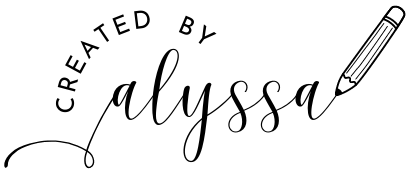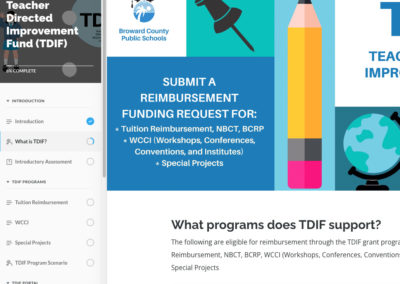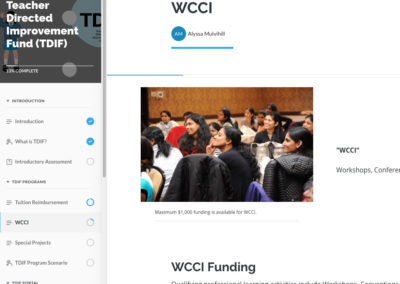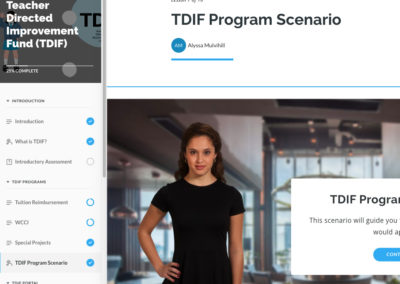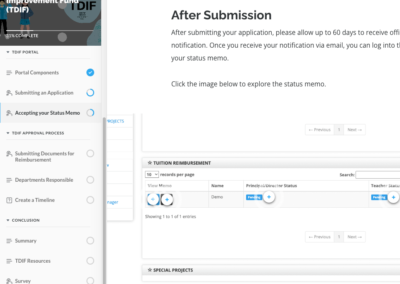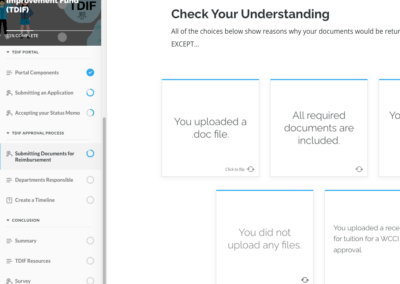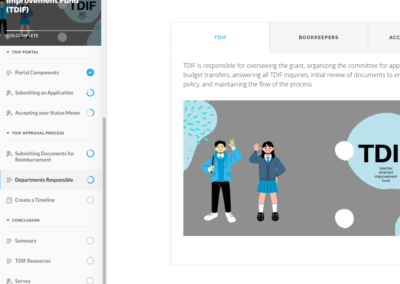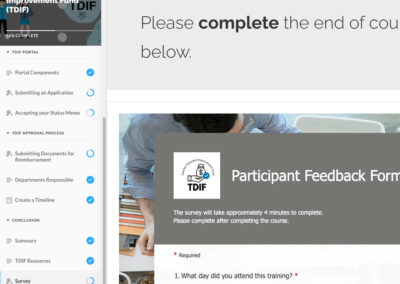Created by Alyssa
Instructional Design on Articulate Rise 360
Goal: In this course, learners will gain an understanding of the TDIF Grant application process. By the end of this course, 100% of qualified teachers will be able to submit a TDIF Grant application for committee review and approval.
Audience
Teachers and Principals within the school district in South Florida (240 representatives).
Responsibilities
Tools Used
KPI
Target Audience and Needs Analysis
The target audience for this training is qualified Teachers and Principals within the school district in South Florida. The years of experience range from 3 years to 30+ years. There are over 15,000 teachers and principals in Broward County (BCPS). One teacher representative per school (240 schools) selected within Curriculum Council, which meets once per month. This group already contains one representative per school that has the expectations of sharing knowledge with their staff.
Based on recent survey feedback from TDIF Applicants, 70% do not fully understand the reimbursement process. This is a grant program that has been available to teachers for over 10 years, and receives 1.7 million dollars in funding per year. Less than 60% of this funding, on average, is utilized on a yearly basis.
Learner Analysis
- Non-Linear Navigation: I have decided to create this e-Learning training utilizing non-linear navigation. A non-linear approach is more suitable for learners to be in control of selecting tasks catering to their skills and knowledge level (Rimmer, 2020). As not all learners will be on the same level coming into the training, this is essential. I want my course to have active involvement and develop learner confidence in selecting tasks to correspond with their creative abilities.
- Interactive Storytelling: To enhance learner engagement and increase learner retention, I plan on embedding interactive storytelling as a piece of my e-Learning. By analyzing examples of interactive stories, (Baldwin, S., & Ching, Y.-H. 2017) identified five features of interactive storytelling: dynamic presentation, data visualization, multisensory media, interactivity, and narration. Since students learn best by doing, weaving in interactive storytelling with real-world examples will be a way to directly engage them.
- Learning Styles: Staying cognizant of different learning styles and incorporating both auditory and visual aspects to a training can also assist with working memory and prevent cognitive overload (Halarewich, 2016). While creating my training, I will be cognizant of incorporating both auditory and visual aspects to help prevent cognitive overload and keep learner interest.
- Learner Retention: To increase learner retention specifically, I will keep in mind the “rule of three”. In my design plan, there are three learning objectives, and while designing slides I will keep the slides to three bullet points.
Design Plan
Goal: In this course, learners will gain an understanding of the TDIF application process. By the end of this course, 100% of qualified teachers will be able to submit a TDIF grant application for committee review and approval.
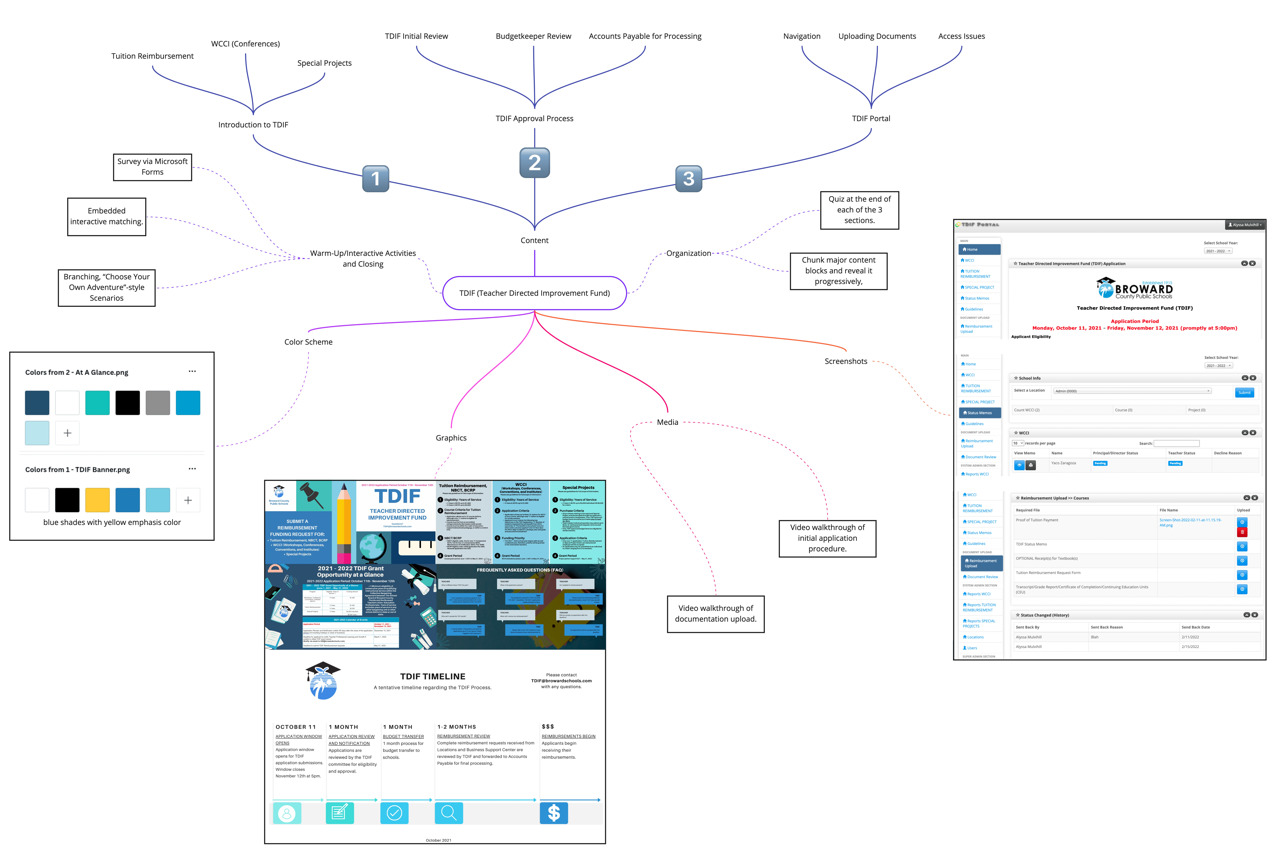
Design Plan
Prior Knowledge
Learning Outcomes
Goal: In this course, learners will gain an understanding of the TDIF application process. By the end of this course, 100% of qualified teachers will be able to submit a TDIF grant application for committee review and approval.
At the end of this module, 100% of learners will be able to
- Understand the difference between the three different TDIF programs.
- Draft a TDIF application.
- Understand the involved district departments in the process and the timeline of events.
Learning Objectives
The learner will…
1. Utilize a graphic organizer (e.g. Venn diagram, t-chart, etc.) to compare the three different grant programs and guidelines.
2. Use the TDIF portal to submit a draft of each of the three grant program applications.
3. Create a timeline of events that occur during the TDIF process.
Instructional Design Model
Assessment Strategies
Formative assessment strategies:
- Graphic Organizer
- Draft TDIF Application (3)
- Timeline
- Quick Knowledge Checks
Summative assessment strategies:
The summative assessment will be an end-of-module quiz to measure the learning that occurred. The performance level should be a 70% or higher to achieve subject-level mastery. The criteria will be directly related to the learning objectives stated prior.
Evaluation
Feedback will be collected via Microsoft Forms survey at the conclusion of the training. The survey will be written using Guskey’s 5 Levels of Professional Development. Based on responses to the survey questions, the course will be modified as needed.
Key Takeaways
Keep it Learner-Centered
Detailed Planning and Problem Solving
Utilizing Feedback
Evaluation
I am a teacher with 34 years in SBBC. I want to take this opportunity to recognize Alyssa (TDIF specialist) for her incredible work ethic, training materials, efficiency and caring disposition. She has been patient and willing to help me understand the process. Her training has directed me and informed me in the most efficient way possible.
- Increase in teacher participation. 90%
- Teachers successfully reimbursed. 99%
More Projects
Microlearning – Nearpod
Created by AlyssaMicrolearning on NearpodThis training focuses on energizers from the Bob Pike Group. Energizers are a specific type of engagement strategy. Strategies are based on Bob Pike trainings I have attended focusing on facilitating to adult learners. The...
Gamification – Articulate Storyline
Created by AlyssaGamification with Articulate StorylineCurated a game for science students learning the parts of the cell and cellular transport. The premise of this game is based on a student scenario in a high school science classroom. This aligns with the following...
Curriculum Development – Canvas
Created by AlyssaCurriculum Development Using Canvas LMSCreated a personalized learning experience for students including playlists, remediation, and enrichment. Since cognitive learning theory and strategies are essential to the fundamentals of lifelong learning, I...
Learn More
About Me
Result-oriented and innovative Project Manager with 8+ years of experience in education, blending expertise in curriculum development, project management, and instructional design. Adept at establishing clear lines of communication with stakeholders, ensuring informed decision-making and successful project outcomes.


Created by Alyssa
Bringing your vision to life.
Links
Home
About Me
Categories
Instructional Design
Project Management
Graphic Design
